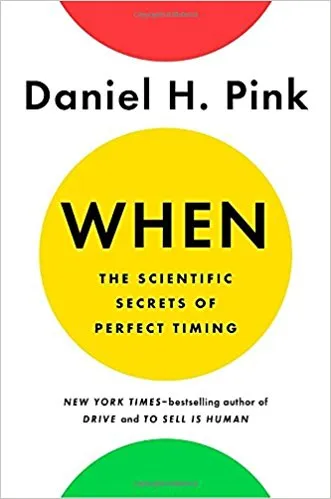
Chronobiology: how trippingly goes the word on the tongue! Time hackers and self optimizers, unite! You’re going to like Daniel Pink’s latest
When: The Scientific Secrets of Perfect Timing. It’s a life hack look in “the branch of biology concerned with natural physiological rhythms and other cyclical phenomena.” Chronobiology, BLAM.
PERFECT TIMING
When came into my life at The Right Time (as
some books do ) to show me that my chronobiology is waaaay off. I’m, like, a babe in the woods, a
you know nothing, Jon Snow when it comes to perfect timing. I’ve never gotten up on the down beat.

About timing, that is.
CHRONOBIOLOGY
I’ve doofusly been going about my day without a care for my complex ancestral circadian rhythms. For instance, I don’t
read in the morning or take a nap of precisely 25 minutes in the afternoon, after imbibing a cup of coffee.
But I should. (The coffee-then-nap is one of Pink’s valuable
Time Hackers Handbook tips offered at the end of each chapter. I wrote down every. single. one in my How To Be A Better Me
book reading bullet journal.)
Pink condenses chronobiology research into nuggets such as
people prefer a chocolate the most when they know its the last one and that
singing in a chorus will instantly “deliver a boost.” Choral singing creates a “synchers high” as we breathe in rhythm with others. I scribbled “join a choir,” in my notebook. Then I drank a coffee and took a nap.
I awoke caffeinated and motored through the afternoon slump called 3 pm! Win!
MID-POINT SLACKING, EXPLAINED BY U-CURVE
In the middle of things we tend to lag (afternoons, midlife, even rituals like lighting the menorah candles for Hanukkah. Science shows we’re most likely to light Day 1 and…Day 8).
This is known in chronobiology as the U-curve.
There are U-curves everywhere, in almost every task and across the lifespan of all animals. Pink writes: “even ape well-being slumps at midlife.” What can you can do about it? Try the Warren Buffet Technique.
“First, write down your top 25 goals for the rest of your life. Second, take a look at that list and circle your top five goals. Third, immediately start planning how to achieve those top five goals. And the other twenty? Throw them away. Get rid of them. Avoid them at all costs.”
How you spend your time is how you live your Life. So have some goals. Coffee-nap toward them. And when it comes to midlife slumps, “rising out of them is as natural as falling in;” sometimes all you have to do is wait.

 Chronobiology: how trippingly goes the word on the tongue! Time hackers and self optimizers, unite! You’re going to like Daniel Pink’s latest When: The Scientific Secrets of Perfect Timing. It’s a life hack look in “the branch of biology concerned with natural physiological rhythms and other cyclical phenomena.” Chronobiology, BLAM.
Chronobiology: how trippingly goes the word on the tongue! Time hackers and self optimizers, unite! You’re going to like Daniel Pink’s latest When: The Scientific Secrets of Perfect Timing. It’s a life hack look in “the branch of biology concerned with natural physiological rhythms and other cyclical phenomena.” Chronobiology, BLAM.











